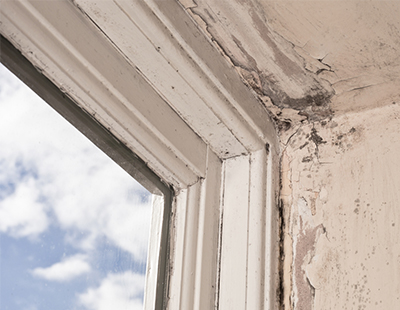Damp and mould are two of the most common issues in rented properties, with surface mould caused by condensation one of the main problems.
When a property is not ventilated properly, excess moisture in the air can’t escape and it will settle on cooler surfaces.
If it’s not wiped away, mildew (small grey/black dots) will start to form and in extreme cases this can develop into a more serious mould problem and spread, damaging both the fabric of the property and its contents. If mould spores are inhaled, it can cause tenants breathing problems, lead to lung infections and could ultimately result in their death.
This is why it’s so important for landlords to ensure the property has appropriate ventilation, and for tenants to use extractor fans provided in kitchens and bathrooms, open windows, wipe away condensation and keep the property adequately heated.
However, there is often confusion over who should deal with damp and mould issues, given that:
- tenants are responsible for taking care of their rented home – which includes keeping the property adequately ventilated and heated to prevent damage from condensation
- landlords are responsible for ensuring the property remains in good condition and free from hazards
So, both during a tenancy and at the end, when landlords can propose deducting deposit monies to pay for damage, there can be disputes over which party should pay for fixing this kind of problem – and until now, it’s been a bit of a grey area.
However, in September, the DHULC published guidance that clarifies the issue and put the responsibility firmly in the landlord’s court.
The new guidance makes it clear that tenants should not be blamed, stating: “Damp and mould in the home are not the result of ‘lifestyle choices’, and it is the responsibility of landlords to identify and address the underlying causes of the problem”. It also says that landlords must treat cases of damp and mould “with the utmost seriousness and act promptly to protect their tenants’ health.”
How to identify and deal with damp and mould
Given the new guidance, it’s vital you (or your agent) knows how to spot and deal with this problem. Bear in mind that your tenant might not report having an issue, so it’s important that you or your agent takes particular care to look for signs of damp and mould during periodical inspections.
Areas where surface mould is commonly found include:
- On window sills
- On walls, particularly behind furniture
- On bathroom ceilings, especially above showers
- In rooms where laundry is left to dry
Small patches can be dealt with by using an anti-fungal spray and it’s worth considering the use of specialist anti-mould paint in rooms where moisture tends to collect, such as kitchens, bathrooms and laundry rooms. And ensure tenants are reminded that they can help avoid the problem reoccurring by ventilating properly and wiping away any condensation that collects.
However, there may be a bigger damp issue:
- Rising damp is caused by moisture seeping in the from the ground, so it only affects the ground floor of a property and will show up as damp patches and ‘tide marks’ on the lower part of walls. This will be due to either an existing damp course failing, or the property may never have had one – in either case, you need to consult a damp specialist.
- Penetrating damp is caused by water coming in from the outside or an internal leak and will appear as patches on the wall or ceiling. In this case, you should have an experienced builder and/or roofing contractor inspect the property to identify and fix the problem.
Visit the Government website for their updated guidance on how to identify and address damp and mould.
* Allison Thompson is National Lettings Managing Director at Leaders Romans Group *
Want to comment on this story? Our focus is on providing a platform for you to share your insights and views and we welcome contributions.
If any post is considered to victimise, harass, degrade or intimidate an individual or group of individuals, then the post may be deleted and the individual immediately banned from posting in future.
Please help us by reporting comments you consider to be unduly offensive so we can review and take action if necessary. Thank you.




.jpg)









.jpg)





.png)





Join the conversation
Jump to latest comment and add your reply
I work for a Local Authority and regularly inspect private rented properties for hazards including damp and mould. If a property is free from defects that are causing a rising and or penetrating damp , there are no water leaks from internal services AND the heating system has timer and thermostat controls, there is functioning mechanical extraction in the kitchen and bathroom and controllable passive ventilation (such as trickle vented), and the insulation is good then mould caused by condensation is likely to be due to lifestyle aspects including lack of use of dehumidifiers when washing clothes and or not using ventilation or adequate heating therefore very unlikely I would be instructing a landlord to rectify any mould as there would be no justification to take action under Part 1 of the Housing Act 2004 as there won’t be any defects or deficiencies. If landlord check their properties against the ideals as guidance stipulates there is almost no likelihood an Authority would take any action against them for reasons stated above.
What a load of cr*p. Most problems are caused by tenants dying clothes, having showers, cooking etc without using extractor fans, opening windows etc resulting in condensation. Just another stick to whack landlords with. No wonder I'm selling up!
I am going through this fiasco with a modern 2008 centrally heated, double glazed EPC " C" two bed flat. Never any problems until new tenants moved in, had a baby, kept all windows shut, and dry all their clothing indoors. Three visits from EH who seemingly can't make a decision. I know what its. They know what it is- but they are holding back as they know a Section 21 will be on the way as soon as they say " tenant lifestyle" . It's a way of keeping the tenants in a home as they went to the council for a council house, said it was
" mouldy" and wanted to move. Surprise surprise a Section 239 Inspection notice x 3. My condensation assessor is going in next week.
Once I get the tenant lifestyle diagnosis I will be issuing a Section 21.Then selling.
Sounds a sensible plan 👌🏻💵💵
EH officers will not be using the phrase “tenant lifestyle” as that is now a taboo phrase. Instead they will be giving advice to tenants on how they can modify their behaviour to reduce moisture production (lids on pans, dry washing outside if possible etc) and how to get rid of moist air by ventilation of the rooms. Some may think that telling tenants how to change their behaviour amounts to saying this is a lifestyle issue, but I bet those actual words won’t be used by many professionals now unless they want to defend complaints rolling in from tenants taking offence.
This infuriates me. In some, if not many cases mould caused by condensation IS lifestyle choices. I let a flat which I used to live in myself so I know full well there is nothing wrong with it. It has never had mould issues even when it had single glazing IF you ventilated. I fitted double glazing WITH vents on all windows several years ago and tell all my tenants to make sure they stay open whenever possible. Those that listened never have a problem. On two brief occasions the flat got mould because by their own admission they refused to ventilate the property to save on energy bills. So they have damaged my property by choosing to ignore advice and put their own health at risk and somehow this is MY fault?!
So! I have let one of my Properties for 16 years, in that time I have had 5 Tenants.
The current Tenant has mentioned ( not complained) mould. I have explained the reason is lack of ventilation, but she can’t get her head around it. The Bathroom is in the middle of the House, but has a ceiling fan vented through the roof. However I have visited 3 times in 6 months, to find the fan isolation switch is turned off.
What the hell can a Landlord do about retards like this?.
My electrician now wires them in such a way so if switched off it also kills the light in the bathroom, doesn't stop then taping over the fan grill though
Issue S21.
Andrew not a good idea really if it goes off with the light you can’t set the fan timer over run.
Hard luck today with the canaries you needed Edwina, let’s be having you 😂👍
at least the fan is working while they are in there, as for the canaries not bothered as not a football ran
I've had a huge problem with a flat where there are leaks from above causing damp and mould in my flat - the landlord of the flat above does not live there so tenants unable to help. The leaks do not affect the flat above so cannot get any action to repair the leaks above
Please login to comment